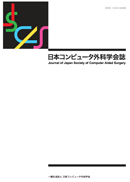巻号一覧

14 巻 (2012)
- 4 号 p. 443-
- 2 号 p. 63-
- 1 号 p. 5-
14 巻, 1 号
選択された号の論文の3件中1~3を表示しています
- |<
- <
- 1
- >
- >|
原著
-
河合 俊和, 橋田 淳, 申 明奎, 西澤 祐吏, 中村 達雄, 森田 直也, 室谷 友哉, 望月 修一2012 年14 巻1 号 p. 5-14
発行日: 2012年
公開日: 2015/10/30
ジャーナル フリーLocally operated detachable end-effector manipulator (LODEM) that can support endoscopic surgery to expand the field of view effectively when operated by doctors working near the patient was developed. We proposed a third arm that collaborated and coexisted with the surgeon in clean area. It was based on a manipulator with detachable commercial forceps for handling internal organs that were operated by the surgeon locally and intuitively. The manipulator with five degrees of freedom was composed of a tool-positioning arm and detachable forceps with a wire-driven mechanism. The manipulator attached to the forceps was operated by the surgeon's hand or foot. The tip of the forceps, working through a restrained pivot point, was controlled in the horizontal and inserting directions. We made a prototype, and the dynamic characteristics were experimentally measured. LODEM was applied in experiments on the task model for operability and laparoscopic cholecystectomy for a beagle dog. It was confirmed that its operational, holding and tractive functions were good enough for practical use. The results of these experiments were being applied so that LODEM can be further improved for clinical use. It is concluded that this newly developed LODEM will be a great help in further developing robotic-assisted solo surgery.抄録全体を表示PDF形式でダウンロード (9427K) -
左 思洋, 正宗 賢, 桑名 健太, 土肥 健純2012 年14 巻1 号 p. 15-25
発行日: 2012年
公開日: 2015/10/30
ジャーナル フリーSingle port access (SPA) surgery is a laparoscopic procedure using only one transumbilical-placed port. Natural orifice transluminal endoscopic surgery (NOTES) offers the possibility of surgery without visible scars. To address the access and stability problems in SPA and NOTES, we developed a device called rigid-flexible outer sheath. This sheath can be switched between flexible and rigid modes by a novel pneumatic shapelocking mechanism, and it has a double curvature structure that enables it to flex in four directions at the distal end and three directions on the rigid-flexible shaft. The insertion part of the prototype is 300 mm long with a 20 mm outer diameter, and the part is equipped with four working channels. All parts of this device are made of plastic and are MRI-compatible. Insertion performance in a phantom experiment was evaluated in an open MRI environment. The experimental results showed that the outer sheath could follow a curved path, and that the sheath was compatible with an MRI environment. In vivo experiments using a swine show that the outer sheath has high potential for solving access and stability problems. We expect that the outer sheath will be useful for SPA and NOTES.抄録全体を表示PDF形式でダウンロード (11229K) -
音丸 格, 中本 将彦, 岡田 俊之, 高尾 正樹, 菅野 伸彦, 多田 幸生, 富山 憲幸, 佐藤 嘉伸2012 年14 巻1 号 p. 27-37
発行日: 2012年
公開日: 2015/10/30
ジャーナル フリーThis paper describes an automated 3D acetabular cup planning method in total hip arthroplasty. A number of past preoperative plans prepared by experienced surgeons and used for actual computer navigated surgery are utilized to model surgeon’s expertise of surgical planning. We construct “pelvis-cup merged statistical shape model (PC-SSM)” by applying principal component analysis to mergers of cup shape and pelvis shape. The cup shape has size, position, and orientation planned by experienced surgeon. The PC-SSM is fitted to the patient pelvis to automatically generate the preoperative plan. According to the performance evaluation, cup size errors between the proposed method and the experienced surgeon’s plans were within one size in 34 cases out of 38 cases. Since the PC-SSM is automatically constructed from training datasets while the previous method based on a manual definition of criteria, we consider the proposed method may be useful for quantitative evaluation of surgeons’ trends for cup planning as well as for automated planning. As a remaining problem, the performance in severely diseased pelvis is needed to be improved.抄録全体を表示PDF形式でダウンロード (2718K)
- |<
- <
- 1
- >
- >|